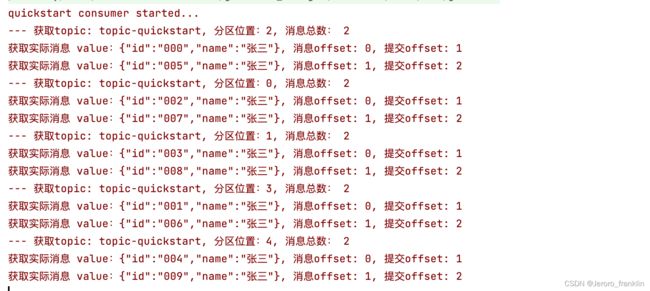kafka-- 创建最基础的生产者和消费者
创建最基础的生产者和消费者
1、 创建maven项目
learn-kafka
com.bfxy
2、引入pom依赖
<project xmlns="http://maven.apache.org/POM/4.0.0" xmlns:xsi="http://www.w3.org/2001/XMLSchema-instance" xsi:schemaLocation="http://maven.apache.org/POM/4.0.0 http://maven.apache.org/xsd/maven-4.0.0.xsd">
<modelVersion>4.0.0modelVersion>
<parent>
<groupId>org.springframework.bootgroupId>
<artifactId>spring-boot-starter-parentartifactId>
<version>2.1.5.RELEASEversion>
<relativePath/>
parent>
<groupId>com.bfxygroupId>
<artifactId>learn-kafkaartifactId>
<version>0.0.1-SNAPSHOTversion>
<dependencies>
<dependency>
<groupId>org.springframework.bootgroupId>
<artifactId>spring-boot-starter-webartifactId>
<exclusions>
<exclusion>
<groupId>org.springframework.bootgroupId>
<artifactId>spring-boot-starter-loggingartifactId>
exclusion>
exclusions>
dependency>
<dependency>
<groupId>org.springframework.bootgroupId>
<artifactId>spring-boot-starter-testartifactId>
<scope>testscope>
dependency>
<dependency>
<groupId>org.projectlombokgroupId>
<artifactId>lombokartifactId>
dependency>
<dependency>
<groupId>org.springframework.bootgroupId>
<artifactId>spring-boot-starter-log4j2artifactId>
dependency>
<dependency>
<groupId>com.alibabagroupId>
<artifactId>fastjsonartifactId>
<version>1.2.58version>
dependency>
<dependency>
<groupId>org.apache.kafkagroupId>
<artifactId>kafka_2.12artifactId>
dependency>
dependencies>
<build>
<finalName>learn-kafkafinalName>
<resources>
<resource>
<directory>src/main/javadirectory>
<includes>
<include>**/*.propertiesinclude>
<include>**/*.xmlinclude>
includes>
<filtering>truefiltering>
resource>
<resource>
<directory>src/main/resourcesdirectory>
resource>
resources>
<plugins>
<plugin>
<groupId>org.springframework.bootgroupId>
<artifactId>spring-boot-maven-pluginartifactId>
<configuration>
<mainClass>com.bfxy.kafka.api.ApplicationmainClass>
configuration>
plugin>
plugins>
build>
project>
3、全局启动类
package com.bfxy.kafka.api;
import org.springframework.boot.SpringApplication;
import org.springframework.boot.autoconfigure.SpringBootApplication;
@SpringBootApplication
public class Application {
public static void main(String[] args) {
SpringApplication app = new SpringApplication(Application.class);
app.run(args);
}
}
4、创建最基础的生产者
package com.bfxy.kafka.api.quickstart;
import java.util.Properties;
import org.apache.kafka.clients.producer.KafkaProducer;
import org.apache.kafka.clients.producer.ProducerConfig;
import org.apache.kafka.clients.producer.ProducerRecord;
import org.apache.kafka.common.serialization.StringSerializer;
import com.alibaba.fastjson.JSON;
import com.bfxy.kafka.api.Const;
import com.bfxy.kafka.api.User;
public class QuickStartProducer {
public static void main(String[] args) {
Properties properties = new Properties();
// 1.配置生产者启动的关键属性参数
// 1.1 BOOTSTRAP_SERVERS_CONFIG:连接kafka集群的服务列表,如果有多个,使用"逗号"进行分隔
properties.put(ProducerConfig.BOOTSTRAP_SERVERS_CONFIG, "172.16.144.133:9092");
// 1.2 CLIENT_ID_CONFIG:这个属性的目的是标记kafkaclient的ID
properties.put(ProducerConfig.CLIENT_ID_CONFIG, "quickstart-producer");
// 1.3 KEY_SERIALIZER_CLASS_CONFIG VALUE_SERIALIZER_CLASS_CONFIG
// Q: 对 kafka的 key 和 value 做序列化,为什么需要序列化?
// A: 因为KAFKA Broker 在接收消息的时候,必须要以二进制的方式接收,所以必须要对KEY和VALUE进行序列化
// 字符串序列化类:org.apache.kafka.common.serialization.StringSerializer
// KEY: 是kafka用于做消息投递计算具体投递到对应的主题的哪一个partition而需要的
properties.put(ProducerConfig.KEY_SERIALIZER_CLASS_CONFIG, StringSerializer.class.getName());
// VALUE: 实际发送消息的内容
properties.put(ProducerConfig.VALUE_SERIALIZER_CLASS_CONFIG, StringSerializer.class.getName());
// 2.创建kafka生产者对象 传递properties属性参数集合
KafkaProducer<String, String> producer = new KafkaProducer<>(properties);
for(int i = 0; i <10; i ++) {
// 3.构造消息内容
User user = new User("00" + i, "张三");
ProducerRecord<String, String> record =
// arg1:topic , arg2:实际的消息体内容
new ProducerRecord<String, String>(Const.TOPIC_QUICKSTART,
//使用alibaba的fastjson
JSON.toJSONString(user));
// 4.发送消息
producer.send(record);
}
// 5.关闭生产者
producer.close();
}
}
package com.bfxy.kafka.api;
import lombok.AllArgsConstructor;
import lombok.Data;
import lombok.NoArgsConstructor;
@Data
@NoArgsConstructor
@AllArgsConstructor
//因为在value处已经做了序列化,此处就不用做序列化了
public class User {
private String id;
private String name;
}
5、创建最基础的消费者
package com.bfxy.kafka.api.quickstart;
import java.time.Duration;
import java.util.Collections;
import java.util.List;
import java.util.Properties;
import org.apache.kafka.clients.consumer.ConsumerConfig;
import org.apache.kafka.clients.consumer.ConsumerRecord;
import org.apache.kafka.clients.consumer.ConsumerRecords;
import org.apache.kafka.clients.consumer.KafkaConsumer;
import org.apache.kafka.common.TopicPartition;
import org.apache.kafka.common.serialization.StringDeserializer;
import com.bfxy.kafka.api.Const;
public class QuickStartConsumer {
public static void main(String[] args) {
// 1. 配置属性参数
Properties properties = new Properties();
properties.put(ConsumerConfig.BOOTSTRAP_SERVERS_CONFIG, "172.16.144.133:9092");
// org.apache.kafka.common.serialization.StringDeserializer 反序列化
properties.put(ConsumerConfig.KEY_DESERIALIZER_CLASS_CONFIG, StringDeserializer.class.getName());
properties.put(ConsumerConfig.VALUE_DESERIALIZER_CLASS_CONFIG, StringDeserializer.class.getName());
// 非常重要的属性配置:与我们消费者订阅组有关系
properties.put(ConsumerConfig.GROUP_ID_CONFIG, "quickstart-group");
// 常规属性:会话连接超时时间
properties.put(ConsumerConfig.SESSION_TIMEOUT_MS_CONFIG, 10000);
// 消费者提交offset: 自动提交 & 手工提交,默认是自动提交
properties.put(ConsumerConfig.ENABLE_AUTO_COMMIT_CONFIG, true);
properties.put(ConsumerConfig.AUTO_COMMIT_INTERVAL_MS_CONFIG, 5000);
// 2. 创建消费者对象
KafkaConsumer<String, String> consumer = new KafkaConsumer<>(properties);
// 3. 订阅你感兴趣的主题:Const.TOPIC_QUICKSTART
consumer.subscribe(Collections.singletonList(Const.TOPIC_QUICKSTART));
System.err.println("quickstart consumer started...");
try {
// 4.采用拉取消息的方式消费数据
while(true) {
// 等待多久拉取一次消息
// 拉取TOPIC_QUICKSTART主题里面所有的消息
// topic 和 partition是 一对多的关系,一个topic可以有多个partition
ConsumerRecords<String, String> records = consumer.poll(Duration.ofMillis(1000));
// 因为消息是在partition中存储的,所以需要遍历partition集合
for(TopicPartition topicPartition : records.partitions()) {
// 通过TopicPartition获取指定的消息集合,获取到的就是当前topicPartition下面所有的消息
List<ConsumerRecord<String, String>> partitionRecords = records.records(topicPartition);
// 获取TopicPartition对应的主题名称
String topic = topicPartition.topic();
// 获取当前topicPartition下的消息条数
int size = partitionRecords.size();
System.err.println(String.format("--- 获取topic: %s, 分区位置:%s, 消息总数: %s",
topic,
topicPartition.partition(),
size));
for(int i = 0; i < size; i++) {
ConsumerRecord<String, String> consumerRecord = partitionRecords.get(i);
// 实际的数据内容
String value = consumerRecord.value();
// 当前获取的消息偏移量
long offset = consumerRecord.offset();
// ISR : High Watermark, 如果要提交的话,比如提交当前消息的offset+1
// 表示下一次从什么位置(offset)拉取消息
long commitOffser = offset + 1;
System.err.println(String.format("获取实际消息 value:%s, 消息offset: %s, 提交offset: %s",
value, offset, commitOffser));
}
}
}
} finally {
consumer.close();
}
}
}
主题类
package com.bfxy.kafka.api;
public interface Const {
String TOPIC_QUICKSTART = "topic-quickstart";
String TOPIC_NORMAL = "topic-normal";
String TOPIC_INTERCEPTOR = "topic-interceptor";
String TOPIC_SERIAL = "topic-serial";
String TOPIC_PARTITION = "topic-partition";
String TOPIC_MODULE = "topic-module";
String TOPIC_CORE = "topic-core";
String TOPIC_REBALANCE = "topic-rebalance";
String TOPIC_MT1 = "topic-mt1";
String TOPIC_MT2 = "topic-mt2";
}
6、测试
启动消费者和生产者
http://172.16.144.133:9000
消费者日志输出

